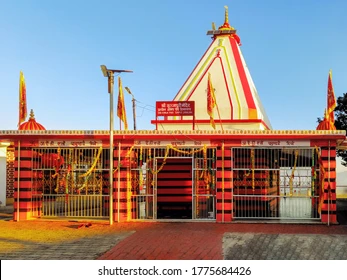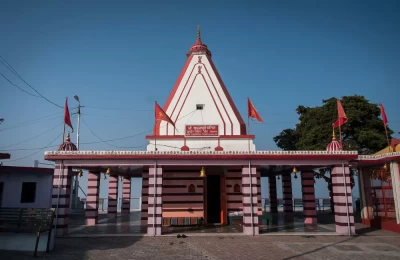

Kunjapuri Temple – Ashu Tour & Travels

Kunjapuri Temple is a revered Hindu temple located in the hills near Rishikesh, Uttarakhand, India. This temple is dedicated to **Goddess Kunjapuri, a form of Shakti and is considered an important Shakti Peetha in the region. The temple holds great significance for devotees who believe that it helps in the removal of obstacles and in fulfilling wishes, particularly those related to personal well-being and spiritual progress.
Key Features of Kunjapuri Temple
- Historical and Mythological Significance:
- Kunjapuri Temple is associated with the legend of Sati, the consort of Lord Shiva. According to Hindu mythology, Sati self-immolated in protest against her father, Daksha’s insult to her husband. After her death, her body was dismembered, and various parts of her body are believed to have fallen at different locations, which are now known as Shakti Peethas. It is believed that Sati’s right breast fell at the site of the Kunjapuri Temple, making it one of the most important Shakti Peethas.
- The temple is dedicated to Goddess Kunjapuri, who is worshipped here in her Shakti form as the goddess of power, and devotees come here seeking blessings for overcoming personal obstacles, gaining strength, and achieving success.
- Temple Architecture:
- The temple structure is simple, yet serene and picturesque. It is set amidst lush green hills, offering breathtaking views of the Shivalik Range and the Ganges Valley. The temple is made of stone and has an open courtyard with a shrine dedicated to Goddess Kunjapuri.
- The sanctum sanctorum contains a Shakti Peeth with the goddess’s idol, where devotees offer flowers, milk, and other traditional offerings as part of their prayers.
- Panoramic Views:
- One of the major attractions of Kunjapuri Temple is the panoramic view it offers. Located at an elevation of around 1,800 meters (5,906 feet) above sea level, the temple provides a stunning view of the surrounding Himalayan ranges. On clear days, you can witness views of the Ganges River, Rishikesh, and the surrounding Rajaji National Park.
- The serene environment and cool breeze further enhance the experience of visiting the temple.
- Tranquil and Spiritual Ambience:
- The temple is relatively less crowded than other temples in the area, providing a peaceful and tranquil atmosphere for meditation, prayers, and reflection. The natural beauty of the place, combined with the divine energy believed to emanate from the temple, makes it an ideal spot for spiritual rejuvenation.
- Festivals and Rituals:
- The temple witnesses large crowds during religious festivals, especially Navaratri and Shivaratri. During these festivals, special pujas (rituals) are performed to honor Goddess Kunjapuri, and devotees from various parts of India gather to offer prayers.
- The temple is open every day for worship, and Aarti is conducted in the early morning and evening hours. Pilgrims who visit seek blessings for prosperity, health, and protection.
Best Time to Visit Kujapuri Temple
- Summer (March to June): The summer months are a great time to visit Kunjapuri Temple, with temperatures ranging between 20°C to 35°C. The weather is pleasant and ideal for trekking and sightseeing. The clear skies and beautiful views make it an excellent time for outdoor activities.
- Monsoon (July to September): The monsoon season brings heavy rains to the region, and it is best to avoid visiting during this period as the roads leading to the temple may become slippery, and landslides are possible. The temple area may also be prone to flooding or waterlogging.
- Autumn (October to November): Autumn is another ideal time to visit, as the weather becomes cooler and more comfortable. The skies remain clear, and the temperature ranges between 10°C to 25°C, making it perfect for trekking and temple visits.
- Winter (December to February): The winter months can be quite cold, with temperatures dropping to around 5°C to 10°C in the daytime. The region may experience snowfall in the higher altitudes. For those who enjoy the chill, winter can be a peaceful time to visit, but it’s important to be prepared for the cold weather and potential frost.
How to Reach Kujapuri Temple
- By Air:
- The nearest airport to Kunjapuri Temple is Jolly Grant Airport in Dehradun, about 35 km (1 to 1.5 hours by car) from the temple. The airport is well-connected to major cities like Delhi, Mumbai, and Bangalore. From the airport, you can hire a taxi or take a bus to reach Rishikesh, and then proceed to the temple.
- By Train:
- The nearest railway station is Rishikesh Railway Station, about 15-20 km (30-40 minutes by car) from the temple. Rishikesh is well connected to other cities like Haridwar, Dehradun, Delhi, and Mumbai. Once you reach Rishikesh Railway Station, you can hire a taxi, auto-rickshaw, or take a local bus to the base of the Kunjapuri Temple.
- By Road:
- Kunjapuri Temple is easily accessible by road from Rishikesh. The temple is located approximately 15 km from the main town of Rishikesh. From Rishikesh, you can take a private car, taxi, or a local bus to the temple. The road leading to the temple is well-paved, though it is slightly uphill, so be prepared for some winding roads as you ascend the hill.
- For those coming from Haridwar, the temple is about 45 km away (approximately 1.5 hours by car), and you can also reach Rishikesh first and then proceed to the temple.
- Trekking:
- The temple is accessible by a short trek from the nearest point, which is Kunjapuri Village. The trek is around 2 to 3 km long, with moderate difficulty, and provides a good opportunity for nature lovers to enjoy the scenic beauty of the area. You can also enjoy a peaceful walk through the nearby forests and hills.
Travel Tips for Visiting Kunjapuri Temple
- Wear Comfortable Shoes: If you plan on trekking, wear comfortable walking shoes, as the road to the temple involves a bit of uphill walking.
- Respect Local Customs: The temple is a sacred place of worship, so it’s essential to dress modestly and maintain silence while inside the temple.
- Carry Water: While the trek is short, it can still be tiring, especially in hot weather. Carry enough water to stay hydrated.
- Food: While there are some small shops near the temple, it’s a good idea to bring light snacks or packed food if you plan to spend a considerable amount of time at the temple.
- Weather Considerations: If visiting in winter or the monsoon season, be sure to pack warm clothes, an umbrella, or rain gear to be prepared for sudden weather changes.
Kunjapuri Temple offers a peaceful and spiritual atmosphere, surrounded by the natural beauty of the Himalayas. It is an ideal destination for those seeking a break from the hustle and bustle of city life, and its serene location makes it perfect for those looking to connect with nature and divinity.









